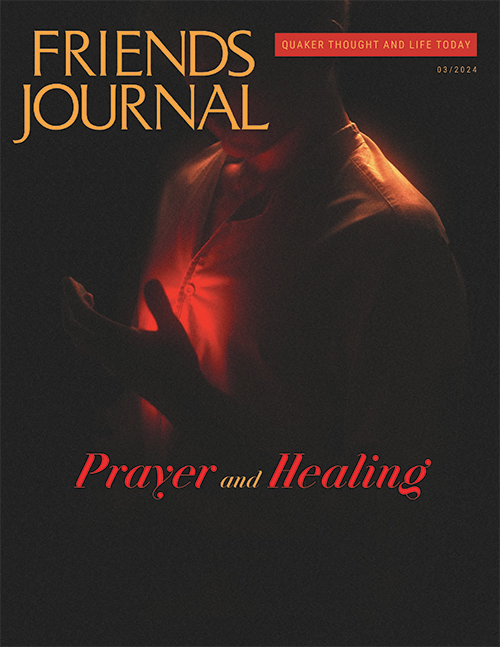Joy, curiosity, and gladness
My favorite part of “Welcoming Joy and Spirit through Accessibility” (by Brittany Koresch with editorial support from Angie Miller, FJ Feb.) is their centering of joy! The changes didn’t feel right until they were undertaken in a spirit of curiosity and gladness.
In Protestant traditions, it can so often feel like austerity is somehow a necessary part of worship and spiritual deepening, as though overcoming discomfort were a rite of passage. But the model here rings true for me—it doesn’t have to be so hard. A deeply felt sense of joy and ease are important indicators of Spirit-led decisions.
Lily Wiest
Ann Arbor, Mich.
The disabled community knocked and North Columbus Friends answered. For a wider spiritual community whose numbers dwindle, we should be focused on how to increase attendance—almost at any cost. In my opinion accessibility is included in stewardship.
Earlham College hosts a semi-programmed meeting for worship at 1:00 p.m., which has featured musical guests. In the Quaker circle I attend here in Marshall, N.C. (under the care of Celo Meeting in Burnsville, N.C.), worship also starts in the afternoon and goes for 45 minutes. It exists because we Friends in Marshall don’t want to drive over an hour to get to worship at 10:00 a.m. Accessibility has been happening and needs to continue to happen.
Mason
Marshall, N.C.
I am enthralled by this, for the idea of what appropriate behavior is for a Friend during worship has now haunted me for the ten years or so that I have been going to meetings. My whole life I have found grounding in writing and drawing, and I have struggled with meditation and waiting in silence. At some times in my life, I have been able to be successfully grounded for the hour-long worship time, but at other times I have struggled so badly to sit there and not move that I have avoided going to meeting. I have found that bringing some artistic activity to stay focused on has calmed my mind. Over the years I have brought a sketchbook with markers, a journal to write in, something to knit or embroider, and even a book to peruse and meditate on. These practices have helped me immensely, but I have never been sure if they were accepted in that space. I have often felt uncomfortable engaging in them; I never asked explicitly. Therefore I have been a bit wishy-washy with the consistency of introducing them into the space. I definitely think my attendance would have been better and I would have felt more welcomed if I knew that these practices were defined as not only allowed but cherished.
The authors have pointed out that such activities are essential to us being a welcoming community where everyone can join in worship and have their voices heard. As a former attendee, I am so proud of what they and the meeting have accomplished. I hope other meetings can follow suit. How can we spread this idea to other Friends communities? Do we still need more time to determine best practices and implementation strategies? I can’t wait to visit Columbus, Ohio, again soon and see it in action.
Bonnie Massey
Long Beach, Calif.
Silence, stillness, waiting, and listening are so much more than posture, and indeed, may become a “pose” we assume to fit surrounding culture. Brittany and Friends slip past any stereotyping in an experiment with authentic being, showing us all the way to a more simple and integral practice. I wonder if you might share more on how this way of gathering raises the spirit of goodwill among participants? Thank you!
Don Buckingham
Columbus, Ohio
I know that, because of the publishing process, it’s been a while since this article was written. I wonder how Brittany’s personal experience of waiting worship and their meeting’s support has continued to evolve since then? Are there any new insights they can share now that more time has passed and afternoon meeting for worship has become a more usual part of the meeting’s routine?
Erin Taylor
Macomb, Ill.
Revelations and signposts
“[D]reaming is an essential function of being human, necessary for our health and well-being” (“Quaker Dreams” by Marcelle Martin, FJ Feb.). According to a study by the University of California, Berkeley, dreaming helps us take the sting out of our painful emotional experiences during the hours we are asleep to learn from them and carry on with our lives. Additionally, dreaming enhances creativity and problem-solving, and deep non-REM sleep strengthens individual memories.
Getting enough sleep and allowing ourselves to dream is important. Those having trouble sleeping or dreaming can do many things to improve their sleep quality, such as establishing a regular sleep schedule, avoiding caffeine and alcohol before bedtime, and creating a relaxing bedtime routine.
Edwin Everly
Rantoul, Ill.
As a young child, my mother and I lived with my grandmother and my aunts for a couple of months. At breakfast, each morning, these four women would tell stories to each other, listening with great interest. I recollect wondering how they had all of these experiences that prior night, while I lay fast asleep. I felt left out of their experiences, which I thought were real. They were sharing their dreams, I came to understand much later. I thought that this was the way of morning sharing in families everywhere. We have lost so much of the rich culture of First Peoples. My grandmother tried with all of her might to keep her family safe after the boarding-school fiascos, but bits of the culture survived. Forced denial of one’s culture is a tragedy.
Sharon Gunther
Sharon Hill, Pa.
Dreams have been revelations or signposts in the many dream groups I have participated in. They have been incredible means of learning to know one another deeply. I was first introduced to a dream group at a psychology and religion conference at Lebanon Valley College; then with Jeremy Taylor at Pendle Hill study center in Wallingford, Pa. Since then my spouse, Judy Ballinger, and I have had a long-running dream group in West Reading, Pa., and now at the Simpson House in Philadelphia. In both groups Judy and I have been the only Quakers. I call myself a “max dreamer” as I usually have one, two, or even three dreams each night. I keep a dream journal. Thanks for Marcelle Martin’s history of dreams among Quakers and her affirmation of their importance.
Blair Seitz
Philadelphia, Pa.
Continuing adaptation?
Ashley M. Wilcox’s “Uncrossing the Wires” (FJ Jan.), about her time as interim pastor at New Garden Meeting, is an interesting and timely essay pertinent to all of us, both at home and in our meetinghouses. Many of us, especially in New Jersey, worship in very old and historic buildings. Making necessary upgrades in wiring and plumbing is a challenge, especially for smaller meetings. We should also discuss adaptations for older members such as safety bars in lavatories. It would be helpful to hear more from other meetings about how they are handling the challenge.
Jo Ann Wright
Woodbury, N.J.
Many years ago our Friends meeting took place on the campus of Hobart and William Smith Colleges in Geneva, N.Y. As a former college chaplain, I decided to develop an outreach program to the students and faculty on campus. The first thing I did was introduce myself to the editor of the student newspaper, and I told him that I wanted to place ads in the paper. I came up with some creative and inventive ads and worked with the student newspaper staff to get everything in place. As a result of those relationships, I began to share my journey to the Quaker faith with students and invited them to attend services. The ads also brought students to our meetings. It brought both students who had grown up in the Quaker tradition as well as students who were curious about Quakers. Since New Garden Meeting is right across the street from Guilford College, it seems that this would be a great opportunity to reach out to them since they are so close.
Chester Freeman
Rochester, N.Y.
My first contact with Quakers was due to some very brief ads placed by two women from Santa Barbara (Calif.) Meeting in the student newspaper at the University of California, Santa Barbara campus. After seeing several ads over a period of weeks, I finally visited a small evening meeting for worship in a room just off campus. That was way more than 50 years ago! I hope it still works!
Ruth Flower
Silver Spring, Md.
Correction
In the earlier version of this article, Mason of Marshall, N.C. stated that Clear Creek Meeting in Richmond, Ind. hosted the afternoon meeting for worship at 1:00 p.m. That worship is a program entirely run by Earlham College. We have updated the letter.





Comments on Friendsjournal.org may be used in the Forum of the print magazine and may be edited for length and clarity.